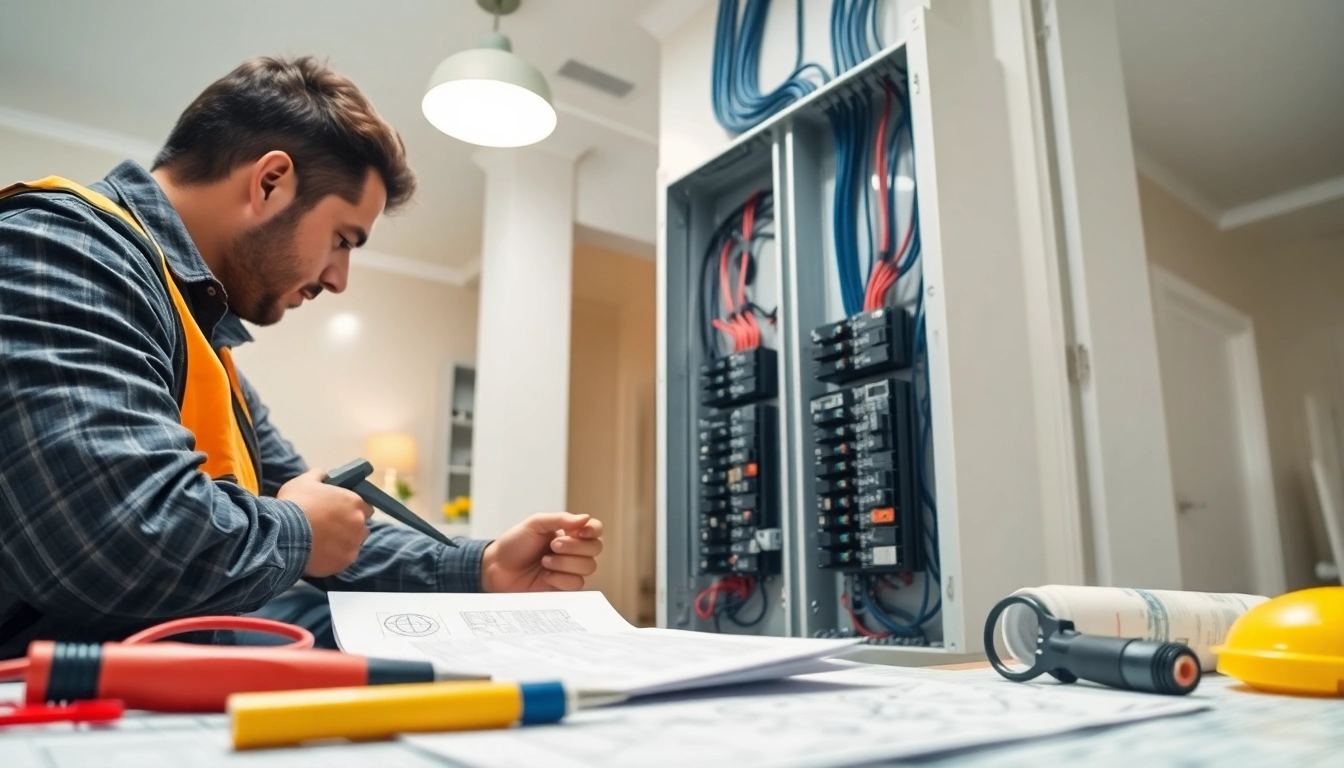Understanding the Electrical Panel: Basics and Functions
What is an Electrical Panel?
The Electrical Panel, often referred to as a breaker box, is a crucial component of a home’s electrical system. It serves as the central hub where power from the utility company enters your home and is distributed to various circuits throughout your space. This distribution is managed by fuses or circuit breakers that protect your home from overloads and short circuits.
In essence, the electrical panel houses all the circuit breakers or fuses that control and protect each of the circuits in your building. This ensures that electrical currents are safely delivered to different parts of your home, providing power for the lighting, appliances, and devices necessary for daily living.
How Does an Electrical Panel Work?
The process begins when electricity flows from the utility company’s lines into the electrical panel. This energized current is then distributed out to various circuit branches that power individual fixtures and outlets. Each circuit breaker is designed to trip (turn off) when the current exceeds the safe threshold, preventing overheating and potential fires.
Additionally, modern electrical panels are equipped with important safety features, such as Ground Fault Circuit Interrupters (GFCIs) and Arc Fault Circuit Interrupters (AFCIs). GFCIs are specifically designed to protect against electrical shock in areas near water, while AFCIs detect hazardous arcing conditions that might lead to fires.
Components of an Electrical Panel
Understanding the various components of an electrical panel can help homeowners appreciate its functionality:
- Main Breaker: This is the switch that controls the power to the entire electrical system. It can turn off electricity to the house all at once.
- Circuit Breakers: These individual breakers control the flow of electricity to specific areas of your home. They can either be single-pole (120V) or double-pole (240V) based on electrical requirements.
- Bus Bars: These are conductive metals that distribute electricity from the main breaker to the circuit breakers.
- Enclosure: This is the housing of the panel that protects its internal components from dust, moisture, and damage.
Signs You Need to Upgrade Your Electrical Panel
Frequent Breaker Trips
One of the most common signs indicating that your electrical panel may need an upgrade is frequent breaker trips. If your breakers frequently trip, it may suggest that your electrical panel is overloaded or that there is a fault. A modern panel allows for higher loads and prevents overloads by safely distributing power without interruptions. Continuous breaker tripping can lead to wear and tear on your devices and appliances, which can be costly over time.
Old or Outdated Equipment
If your home is more than 20 years old, you might have an outdated electrical panel that doesn’t meet today’s energy demands. Older panels, often equipped with fuse boxes, may not handle modern appliances efficiently, leading to insufficient power supply. Upgrading to a modern electrical panel not only enhances safety but also improves performance and adds convenience to your living space.
Increased Power Demands
In recent years, the number of electrical devices in homes has skyrocketed. If you have added high-demand appliances (like electric vehicles, heat pumps, or smart home systems) without upgrading your panel, your current system may struggle to keep up. An insufficient electrical supply can lead to diminished performance of devices and increased risk of electrical hazards. Upgrading your electrical panel to accommodate these additional power requirements is essential for effective energy management.
Evaluating Electrical Panel Options
Types of Electrical Panels
Understanding the types of electrical panels available can inform your decision to upgrade:
- Traditional Circuit Breaker Panels: These are the most common type and are typically found in older homes. They use mechanical breakers that must be reset manually after tripping.
- Smart Panels: These modern panels allow homeowners to monitor and control usage remotely and manage power distribution effectively.
- Subpanels: Used in larger homes, these panels offer an additional electricity distribution point and can reduce the load on the main panel.
Choosing the Right Size for Your Home
When evaluating which electrical panel to upgrade to, consider both the number of circuits needed and the overall load capacity. A common starting point is 200 amps for average-sized homes, which can handle the energy demands of contemporary living. If your home has heavy appliances or is larger than average, you might even consider higher amperage options. An electrical professional can assist in making the right choice based on your specific needs.
Cost Considerations for an Electrical Panel Upgrade
The cost of upgrading an electrical panel can vary widely. Factors that influence this cost include:
- Panel Size: Larger panels often incur higher costs due to increased material and installation requirements.
- Electrical Upgrades: If you are also upgrading wiring or installing additional circuits, this can significantly increase the overall cost.
- Labor Costs: The complexity of the installation will also influence costs. Regions, local electricians’ rates, and accessibility can affect pricing.
On average, a basic panel upgrade can range from $1,500 to $3,000, but the total may go higher depending on additional installations.
Installation Process for an Upgraded Electrical Panel
Preparing for Installation
Before the installation of your new electrical panel, certain preparations must be made:
- Hire a qualified electrician: Ensure that the electrician is licensed and insured, as electrical work can be hazardous.
- Obtain necessary permits: Check with local regulations to determine if permits are required.
- Choose a suitable installation date: Consider scheduling the installation for a time that minimizes disruption to your household.
Step-by-Step Installation Guide
The installation of an electrical panel typically involves the following steps:
- Power Shutdown: The electrician will first turn off power to the existing electrical panel.
- Remove the Old Panel: The existing panel will be taken out, along with any outdated wiring that needs to be replaced.
- Install the New Panel: The new breaker box will be mounted in an accessible location.
- Wiring Connections: All circuit wires will be connected to the appropriate breakers in the new panel.
- Inspection: Finally, an inspection is usually required to ensure compliance with local codes and safety standards before the power is restored.
Safety Measures During Installation
Electrical upgrades can pose serious risks if not executed properly. The following safety measures should always be observed:
- Use Personal Protective Equipment (PPE): Hard hats, goggles, and gloves can protect workers from electrical hazards.
- Clear the Work Area: Ensure the area is free of obstructions and hazards to prevent accidents.
- Follow Local Codes and Regulations: All installations must comply with the National Electrical Code (NEC) and local ordinances.
Maintenance Tips for Your Electrical Panel
Regular Inspections and Testing
Maintaining your electrical panel is essential for its longevity and performance. Schedule periodic inspections with a qualified electrician to evaluate the condition of the panel, identify potential issues, and replace any faulty components. Regular testing of circuit breakers and GFCIs ensures they work effectively and reduces the risk of electrical hazards.
Keeping the Area Clean and Accessible
Maintaining a clear area around your electrical panel is vital for safety. Ensure that the panel is unobstructed and accessible for quick inspections and emergencies. Regularly check for dust accumulation, and clean the area to prevent any fire hazards.
Signs of Wear and How to Address Them
Be alert to signs of wear on your electrical panel, including:
- Burning Smells: A burning odor may signal an electrical problem.
- Discolored Breakers: If any breakers appear discolored, it may indicate overheating.
- Buzzing Noises: Unusual sounds from your panel could indicate an electrical fault or overload.
If you notice any of these signs, contact a licensed electrician immediately to assess and resolve the issue, as proactive maintenance can prevent catastrophic failures.



